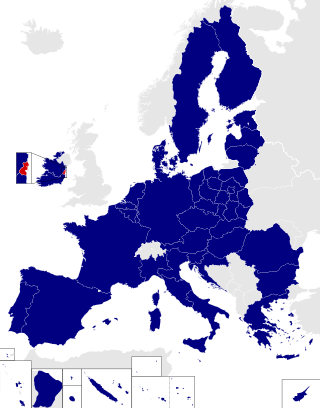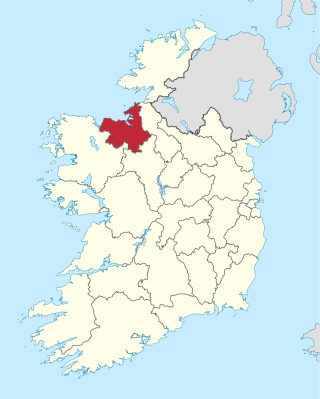
County Sligo is a county in Ireland. It is in the Northern and Western Region and is part of the province of Connacht. Sligo is the administrative capital and largest town in the county. Sligo County Council is the local authority for the county. The population of the county was 70,198 at the 2022 census. It is noted for Benbulben Mountain, one of Ireland's most distinctive natural landmarks.

Ballymote is a market town in southern County Sligo, Ireland. It is around 20 km south of Sligo town in the province of Connacht, which is in the north-west of Ireland. Ballymote lies in the barony of Corran. It is a commuter town with a strong history of independent enterprises along with firm local health, school, and transport services. Ballymote is on the main Dublin to Sligo Train Line, and 10 minutes from the N4 / N17 roads. The town serves a large hinterland area in south east County Sligo.

Eamon Scanlon is an Irish former Fianna Fáil politician who served as a Teachta Dála (TD) from 2007 to 2011 and 2016 to 2020. He was a Senator for the Agricultural Panel from 2002 to 2007.

Sligo–Leitrim is a parliamentary constituency that has been represented in Dáil Éireann, the lower house of the Irish parliament or Oireachtas, from the 2016 general election. The constituency elects 4 deputies on the system of proportional representation by means of the single transferable vote (PR-STV). Another constituency of the same name existed from 1948 to 2007.

Dublin is a European Parliament constituency in Ireland. It elects 4 Members of the European Parliament (MEPs) using proportional representation by means of the single transferable vote.

Donegal is a parliamentary constituency which has been represented in Dáil Éireann, the lower house of the Irish parliament or Oireachtas, since the 2016 general election. The constituency elects 5 deputies on the system of proportional representation by means of the single transferable vote (PR-STV).

Ballymote Castle is a large rectangular keepless castle, built around 1300. It is located in the townland of Carrownanty on the outskirts of Ballymote in southern County Sligo, Ireland. This area was known historically as Átha Cliath an Chorainn, which roughly translates as The Ford of the Hurdles of Corann. It is the last of the Norman castles in Connacht. It was probably built in order to protect the newly won possessions of Richard Óg de Burgh, 2nd Earl of Ulster, in County Sligo, some distance from an earlier motte.
The 1985 Irish local elections were held in all the local government areas on Thursday, 20 June 1985.

An election to Donegal County Council took place on 5 June 2004 as part of that year's Irish local elections. 29 councillors were elected from six electoral divisions by PR-STV voting for a five-year term of office.

An election to Offaly County Council took place on 10 June 1999 as part of that year's Irish local elections. 21 councillors were elected from five local electoral areas for a five-year term of office on the system of proportional representation by means of the single transferable vote (PR-STV).

An election to Offaly County Council took place on 11 June 2004 as part of that year's Irish local elections. 21 councillors were elected from five local electoral areas (LEAs) for a five-year term of office on the electoral system of proportional representation by means of the single transferable vote (PR-STV).

The 2019 Irish local elections were held in all local authorities in Ireland on Friday, 24 May 2019, on the same day as the 2019 European Parliament election and a referendum easing restrictions on divorce. Each local government area is divided into local electoral areas (LEAs) where three to seven councillors are elected on the electoral system of proportional representation by means of the single transferable vote.

An election to all 18 seats on Sligo County Council was held on 24 May 2019 as part of the 2019 Irish local elections. County Sligo was divided into 3 local electoral areas (LEAs) to elect councillors for a five-year term of office on the electoral system of proportional representation by means of the single transferable vote (PR-STV).
Joseph Queenan is an Irish politician. He is a member of the Sligo County Council, first elected for Fianna Fáil in 1999 and representing the Dromore Electoral Area from then until its dissolution and replacement by the newly merged Ballymote and Tubbercurry Electoral Areas ahead of 2014's election. Queenan was re-elected in 2014 representing the Ballymote-Tubbercurry electoral area.

An election to all 21 seats on Wicklow County Council took place on 7 June 1979 as part of the 1979 Irish local elections. County Wicklow was divided into 4 county electoral areas to elect councillors for a five-year term of office on the electoral system of proportional representation by means of the single transferable vote (PR-STV). The term was extended to 1985.

An election to all 28 seats on Donegal County Council took place on 7 June 1979 as part of the 1979 Irish local elections. County Donegal was divided into five county local electoral areas to elect councillors for a five-year term of office on the electoral system of proportional representation by means of the single transferable vote (PR-STV). This term was extended for a further year, to 1985.

An election to all 28 seats on Donegal County Council took place on 18 June 1974 as part of the Irish local elections. Councillors were elected from five local electoral areas for a five-year term of office on the electoral system of proportional representation by means of the single transferable vote (PR-STV).

An election to all 18 seats on Sligo County Council was held on 7 June 2024 as part of the 2024 Irish local elections. County Sligo is divided into 3 local electoral areas (LEAs) to elect councillors for a five-year term of office on the electoral system of proportional representation by means of the single transferable vote (PR-STV).

An election to all 28 seats on Donegal County Council took place on 28 June 1967 as part of the Irish local elections. Councillors were elected from five local electoral areas for a five-year term of office on the electoral system of proportional representation by means of the single transferable vote (PR-STV).

An election to all 28 seats on Donegal County Council took place on 30 June 1960 as part of the Irish local elections. Councillors were elected from five local electoral areas for a five-year term of office on the electoral system of proportional representation by means of the single transferable vote (PR-STV).













